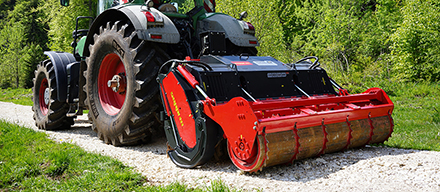STARSOIL by Seppi M was recently completely redesigned with the transmission reinforced and now designed for tractors up to 310 HP. At the same time, brand new technology – the first of its kind in the market was introduced, the 2SPEED-POWERSHIFT transmission. Source: Timberbiz
This “powershift” transmission allows the operator to easily switch from one rotor speed to another from the tractor itself and with the machine running. Unlike the past, when it was necessary to stop the tractor and machine, shift a mechanical lever on the central box, and then restart.
The advantages are clear: fast adaptation to the field conditions and the right operating mode for all work situations.
In slow gear, at about 500 rpm, the machine is suitable for all soil works and stone crushing.
In fast gear, at about 1500 rpm, it is suitable for surface mulching.
Switching occurs through the tractor ISOBUS terminal. This terminal can also be adapted to older tractors without ISOBUS.
Even the temperatures are monitored by the control unit in order to promptly intervene in case of a malfunction in the cooling circuits. The counter, which keeps tabs on the hours and parts subject to wear, and which is now incorporated in the standard supply, is used to monitor the operating costs.
As for the rest, there have been few changes to the nature of the machine itself. The external dimensions are practically identical, that is, an external width of 2.8 m with a fantastic working width of 2.5 m.
A smaller version is also available with external width 2.55 m and working width 2.25 m, which is also approved for road use.
The hydraulically adjustable skids are a new feature these are available on request. Using these, the working depth can be adjusted directly from the driving position which is very practical especially for mulching works requiring minimal contact with the ground. Without these hydraulic guides, the working depth is adjusted using the traditional method, via the position of the support roller.








